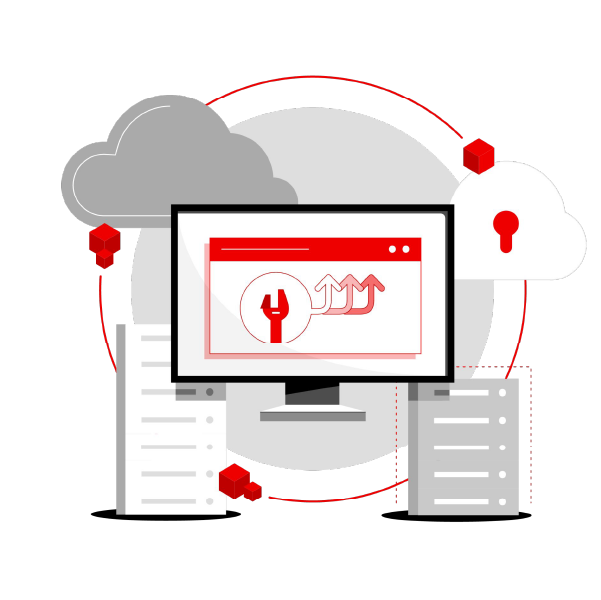Automation Platform
-
Overview Get started
Features
- Ansible Lightspeed
- Ansible plug-ins for Red Hat Developer Hub
- Event-Driven Ansible
- Self-service automation portal
- Automation execution environments
- Automation controller
- Automation mesh
- Ansible Content Collections
- Ansible automation hub
- Automation dashboard and automation analytics
- Ansible development tools
-
All features
-
Use cases -
Integrations Extend your use of Ansible Automation Platform with partner offerings, including certified collections and resources.
-
Deployment options - Documentation
Product feature
Event-Driven Ansible
Use event-driven automation to reduce manual tasks and deliver more efficient mission-critical workflows.
Overview
As a part of your Red Hat® Ansible® Automation Platform subscription, Event-Driven Ansible provides the event-handling capability needed to automate time-consuming tasks and respond to changing conditions in any IT domain.
Event-Driven Ansible can process events containing discrete intelligence about conditions in the IT environment, determine the appropriate response to the event, then execute automated actions to address or remediate the event. It can help you get more out of existing tools by using their observability data to automate actions at every stage of the operational life cycle.
With Event-Driven Ansible, you can codify and share subject matter expertise in automation code to consistently perform mission-critical operations. IT service management tasks—such as ticket enhancement, remediation, and user management—are ideal starting points, but Event-Driven Ansible is flexible enough to automate a variety of tasks across IT environments for better agility and resiliency.
Automate with a powerful, unified platform
Use event-driven automation to work smarter and deliver IT services with precision. Choose the automation style—manual or automatic—needed for a particular action and automate across use cases with a single platform.
Boost speed and responsiveness
Address problems rapidly, before they become urgent issues. Improve mean-time-to-resolution. Reduce time spent on low-level tasks to optimize the use of valuable resources for other priorities.
Implement with flexibility
Easily apply event-driven automation to diverse needs. Subscribe to many event sources. Use YAML to write conditional rules that implement actions in the ways you want—and even call existing playbooks or templates.
Ensure consistency
Codify team knowledge in Ansible Rulebooks to act in the same way every time. Minimize human errors that are often caused by high-volume repetitive tasks and tired staff. Address configuration drift as soon as it occurs.
How does Event-Driven Ansible work?
Event-Driven Ansible connects sources of events with corresponding actions via rules. Ansible Rulebooks define the event source and explain—in the form of conditional “if-this-then-that” instructions—the action to take when the event occurs. Based on the rulebook you design, Event-Driven Ansible recognizes the specified event, matches it with the appropriate action, and automatically executes it. Actions can optionally include executing existing Ansible Playbooks, templates, or modules to extend value from your trusted automation.
Sources
All the sources of event data you want to see.
Rules
What you will create using Event-Driven Ansible.
Actions
Execute when a condition or event is met.
Let’s consider an example. Your observability tool—the event source—is watching network routers and discovers that a router is not responding, recognizing this as an event. Event-Driven Ansible receives this event, finds the corresponding Ansible Rulebook, and matches the event with the desired action—which could be re-applying a configuration, resetting the router, or creating a service ticket. Event-Driven Ansible triggers the instructions in the rulebook and the router is reset, restoring it to normal function. What’s more, this can happen at any time—even at 2 AM, while the network engineer stays asleep.
Ansible Rulebook CLI
This command line interface runs Ansible Rulebooks. It monitors events and delegates the execution of playbooks to Ansible Automation Platform’s existing tooling.
Event-Driven Ansible controller
This tool offers the management, scaling, and observability functionality that enables Event-Driven Ansible to be used effectively in the cloud, on-premise, or across hybrid environments.
Event-Driven Ansible Content Collections
These content collections offer event-source plugin code for a number of provided event sources, as well as Ansible Rulebooks to get new event-driven automation projects started quickly.
Learn about our new integration with Splunk
By using Event-Driven Ansible and Splunk together, you can automate responses to observability alerts—and get more value out of AIOps.
Customer success stories
Xylem introduced Event-Driven Ansible to automate security scans and set up conditional rules for performing time-consuming tasks.
This leading Spanish insurance provider used Event-Driven Ansible to cut their service tickets by 50%, respond to incidents faster, and reduce downtime.
Glen Raven used Event-Driven Ansible to build secure links between cloud-based service management applications and internal automation controllers.
Get started with Event-Driven Ansible
Interactive labs
Take these self-paced, interactive labs to get familiar with Event-Driven Ansible so you can more easily apply it to your needs.
Partner integration webinars
Learn how to integrate with Event-Driven Ansible partners including IBM Instana, CrowdStrike, BigPanda, Palo Alto Networks, and others.
Training
Take this free training course to learn the basics of automating common use cases with Event-Driven Ansible
FAQs
How can Event-Driven Ansible improve IT operations?
Event-Driven Ansible can help you:
- Deliver more value with responsive IT services.
- Automate IT decision making.
- Automate actions based on data from numerous sources of events.
- Streamline IT workflows, especially those that extend beyond normal working hours.
- Improve security and consistency, while reducing downtime.
- Automate routine tasks to free your IT teams for high-value work.
- Respond with speed and efficiency, while improving work-life balance.
What are some use cases for getting started with Event-Driven Ansible?
Red Hat often recommends a “start small, think big” approach to automation, and Event-Driven Ansible is no exception. You can begin by using it to enhance tickets, then progress to completing some simple remediation steps or creating a notification when a certain condition is present in your environment. Then try it for basic user management tasks—like resetting a password—or create a simple self-service model. From there, you can try more advanced use cases: configuration behavior management, more advanced remediation, auto-triggering backups when a change takes place, self-service provisioning, or using an automated GitOps model.
What can I do with Ansible Content Collections?
Red Hat and our partners have created—and are creating—Ansible Content Collections that can help you jumpstart new Event-Driven Ansible projects across your multivendor IT environment. As a subscriber, you can access this certified and supported content in the Ansible automation hub.
Is Event-Driven Ansible included in Ansible Automation Platform?
Yes, Event-Driven Ansible is included in your Ansible Automation Platform subscription for versions 2.4 and higher. Subscribers can take advantage of it at no additional cost by downloading and trying it.
Can Red Hat help me get started with Event-Driven Ansible?
Red Hat Consulting offers expert, hands-on guidance to help you get started with Event-Driven Ansible. This dedicated approach can help your organization mitigate risk while increasing efficiency and speeding your return on investment. Whether you’re just getting started with Ansible Automation Platform, hoping to streamline Event-Driven Ansible integration, or trying to tackle Event-Driven Ansible use cases, our consultants are here to assist you.
Resources
Blog post
What’s new in Event-Driven Ansible, part of Ansible Automation Platform 2.5?
Our latest release includes enhancements like simplified event routing, vault and credential management, authentication and role-based access control, and much more.
Webinar
What’s new: Ansible Automation Platform’s Event-Driven Ansible
Watch this webinar to learn about Event-Driven Ansible's simplified event routing, new partner content collections, and other ease-of-use capabilities—and see the new features in action.
E-book
Event-driven automation for IT Ops
Learn how Event-Driven Ansible can help you build reliable operations by responding quickly and consistently to changing IT conditions.


